#coral morphologic
Text
A Tale of Two Corals (in the Anthropocene): The past summer’s record hot temperatures were devastating to South Florida’s reefs, wiping out a significant percentage of critically important staghorn corals (Acropora cervicornis aka ACER). Staghorn is a keystone species, and the primary coral grown by restoration practitioners in the Caribbean. They grow fast, but can die a lot faster.
In 2009 we discovered a unique strain of staghorn coral that had naturally recruited to one of the breakwaters on nearby Fisher Island. Since 2020 we’ve been helping NOAA cultivate fragments of this urban ACER on an experimental nursery adjacent to the Camera.
In conjunction with University of Miami’s Rescue a Reef program we’ve been using the CCC site to test the resilience of staghorn corals they grow offshore. Like other FL restoration orgs, Rescue a Reef saw many of their outplanted ACER die this past summer. Finding strains that can withstand future heat stress is critical for long term success in restoring our reefs.
As seen in this 7 month timelapse, a fragment of urban ACER (we’ve dubbed the ‘Ventura’ strain) not only didn’t bleach, but grew at a significant rate. The 2nd staghorn, one of the offshore strains, began strong, but quickly bleached, died, and then was eroded away by parrotfish.
In early August, UM transported fragments of the ‘Ventura’ strain offshore where the water was cooler for safekeeping. While the ‘Ventura’ strain has proven successful in the nearshore environment, it is important to see how it fares in deeper water before amplifying it for restoration purposes. We are pleased to hear from Rescue a Reef that it is thriving in its new environment!
Preliminary analysis of the ‘Ventura’ strain shows it is hosting Durusdinium glynni zooxanthellae, a symbiont known to provide massive corals with thermal tolerance. However, its presence in Caribbean staghorn corals is previously undocumented. Could ACER ‘Ventura’ help restore Miami’s inshore and offshore reefs? Can it confer resilient genetics to future offspring by spawning it in a lab? These are some of the exciting questions we seek to answer in the future!
41 notes
·
View notes
Text
"Virtual Aquarium"
Whenever I find myself far from the ocean I pull this site up. Technology is wonderful and so are the folks who placed and maintain this underwater camera off of Miami. It's better than an aquarium because the fish are in their natural environment! Grab a cup of coffee and enjoy.
* scroll to the bottom of the screen and you can add a soothing musical background...they thought of everything!
0 notes
Text
<3 <3 obviously one of the highlights of my visit to the national aquarium the other day was the reptiles <3 <3 specifically the snakes, SPECIFICALLY the death adder omgggg.
there is something so??????????? magical???????????? about being able to put your face just inches away from something that, if it were to bite you, would definitely kill you.
like, to have a thin lil pane of glass be all that keeps a small but very deadly beast from being able to end my life????????????
amazing.
#obligatory Fun Facts about death adders that nobody asked for lmao#“adder” is a term most accurately describing vipers belonging to the genus “bitis”#puff adders like gaboon vipers or european common adders#but death adders aren't true adders! because they're not vipers! they're elapids!#and they're remarkable among elapids for having a VERY different body shape!#elapids include cobras and mambas and coral snakes#and have morphology that is very similar to most colubrids#which include king snakes and rat snakes and garter snakes#they tend to be very slender relative to their length#with heads that are roughly the same size as their necks#but death adders are shaped pretty much exactly like a bona fide viper#with a stout and heavy body#a narrow neck#and a bigass triangular head!#somebody who didn't know they were looking at a death adder would have no reason to assume it wasnt a viper#and idk its just so rad to me that Science People can figure out when things aren't as they seem!#like omg how hard did they have to look at it to figure out it wasn't a viper????#i woulda just taken one look at that thing and said 'yep thats a viper' and called it a day#fuck i look like getting close enough to a Very Deadly Snake to determine that its not what it looks like?????#i swear if it was up to me there would be like no science being done on dangerous animals lmaoooo#i love them but dear god put that thing back where it came from or so help me
1 note
·
View note
Text


A two for one post today.
Dragon posts for Smaugust.
The Maple Leaf Drake is a small to medium sized woodland dragon that populates temperate forests across the globe. Their unique body morphology allows them to hide, almost seamlessly, amongst vast maple forests. This physiological adaptation also extends to seasonal color changes throughout the year. They will live their lives hidden amongst the leaves, using their long proboscis bill to pierce through the bark of Maple Trees to extract the sweet sap, which makes up the majority of it’s diet.
Incredibly skittish, the Fearful Precious Red Coral Drake lives it’s life hidden amongst Red Coral. It’s long proboscis-like mouth snatching up small unsuspecting pray.
#concept art#creature design#fantasy art#creature concept#concept design#monster#creature#dragons#speculative evolution#sea monster#sea dragon#maple tree#forest spirit#fantasy illustration#bestiary#forest dragon#dragon concept art#smaugust#smaugust 2023
5K notes
·
View notes
Text
What Is and Isn't a Fish: a List
A list of the animals I discussed in my fish essay, but for those who don't want to scroll through paragraphs of text to find out if an animal is or isn't a fish. Just CTRL+F your way through here!
I'll add onto here more animals whenever I get asked about them being fish. See my fish essay here!
Some notes before you proceed:
Yes, all tetrapods are fish! We are phylogenetically fish, as we are and our ancestors were lobe-finned fish! "Fish" in the phylogenetic sense is a paraphyletic group if you try to exclude tetrapods, so it is frankly impossible.
How come tetrapods aren't listed as fish then? Long answer, read my essay. Short answer, me and other fish accounts tend to operate on the morphological definition of fish, so does most of the world. Here I use the morphological definition of "fish".
Fish:
Jawless fish
Hagfish
Lamprey
Cartilaginous fish
Sharks
Dogfish
Whale shark
Chimaeras/Chimeras/Ghost sharks
Ratfish
Ray
Stingray
Skate
Ray-finned fish
Teleosts
Catfish
Eels
Moray eel
Seahorse
Sea dragon
Lobe-finned fish
Coelacanth
Lungfish
Not Fish:
Crustaceans
Krill
Shrimp
Crab
Crayfish/Crawfish/Crawdad
Lobster
Spiny lobster
Triops
Mantis shrimp
Barnacle
Isopod
Copepod
Shellfish
Mollusks/Molluscs
Gastropods
Sea snail
Sea slug
Snails and slugs in general
Sea angel
Sea hare
Sea bunny
Cephalopods
Octopus
Squid
Cuttlefish
Nautilus
Inkfish
Bivalves
Clam
Mussel
Scallop
Oyster
Chiton
Chelicerates
Horseshoe crab
Sea spider
Water mite
Diving bell spider
Cnidarians
Jellyfish/Sea jelly/Jelly
Coral
Sea anemone/Anemone
Siphonophores
Portugese man o' war
Echinoderms
Sea cucumber
Sea pig
Feather star
Sand dollar
Sea biscuit
Sea cookie
Brittle star/Serpent star
Sea urchin
Starfish/Sea star
Comb jelly
Lancelet
Tunicates
Sea squirt
Salp
Annelids
Bristle worm
Bobbit worm
Spoon worm
Giant tube worm
Bone-eating worm
Sea mouse/Sea mice
Feather duster worm
Christmas tree worm
Leech
Flatworm
Amphibians
Salamander
Amphiuma
Mudpuppy/Mud puppy
Waterdog
Olm
Axolotl
Siren
Frog
Toad
Tadpole
Caecilian
Reptiles
Sea snake
Water snake
Snakes in general
Sea krait
Turtle
Snapping turtle
Softshell turtle
Sea turtle
Terrapin
Marine iguana
Crocodilian
Crocodile
Alligator
Caiman
Gharial
Bird
Penguin
Seagull
Loon
Swan
Mammals
Whale
Orca
Baleen whale
Toothed whale
Dolphin
River dolphin
Porpoise
Narwhal
Beluga whale
Sperm whale
Pinniped
Seal
Sea lion
Leopard seal
Elephant seal
Walrus
Sirenian
Manatee
Sea cow
Dugong
Otter
Sea otter
Beaver
Hippo
Platypus
Muskrat
Water shrew
323 notes
·
View notes
Text
I must make an apology. Last Wet Beast Wednesday I declared that I was balancing out the vertebrate/invertebrate balance of this series. However, I realized that all the invertebrates I've covered have been arthropods. This is a grave misrepresentation of invertebrate diversity and I must make amends. Thus, this week we're returning to the no bone zone and talking about siphonophores.

(Image: a collage of different siphonophore species, sourced from Wikipedia)
Siphonophores are cnidarians: soft-bodies, radially symmetrical organisms that also include jellyfish, anemones, and corals. They are definitely amongst the weirdest of cnidarians. Most of them look like either a jellyfish or an anemone, but siphonophores run a whole gamut of shapes: from the jellyfish-like Portugese man-o-war to the vaguely comb jelly-like Praya dubia, to whatever the heck this thing is

It looks like a bunch of glass vases on a stick (image: Marrus orthocanna)
Their appearance is the least weird thing abut them. Siphonophores are colonial organisms. Each individual animal is composed of multiple smaller organisms called zooids. All zooids share the same DNA, but are specialized to perform different functions as determined by their morphology. Because each type of zooid is specialized to perform a single function, they are dependent on each other to survive and cannot exist alone. Cnidarians exist in two forms, which many will switch between during their life cycle: sessile polyps and mobile medusas. Siphonophores do this differently, with each zooid type being either a medusa of a polyp. Biologists have described multiple types of zooids found across many species of siphonophore. These include nectophores (used for propulsion), gastrozooids (used for digestion), palpons (used to regulate gastrovascular fluids), gonophores (used in reproduction), and pneumatophores (gas-filled floats only found in some species).

(image: a diagram of different zooid types. Source)
There are 175 known species of siphonophore. The majority of species are pelagic, remaining in open water their entires lives, though a few reside on the sea floor. While they do have some ability to direct their movements, like jellyfish, they are often pulled along by currents. The majority of species live in the deep sea and deep-sea species are often larger than shallow-sea species. Like their jellyfish and anemone relatives, siphonophores are predators who use tentacles to capture prey. Each tentacle is covered with stinging cells called nematocysts that fire venom-coated barbs into organisms that touch them. The prey is then pulled into gastrozooids and digested. Most species are capable of bioluminescence, which is likely used for defense. Some species also develop bioluminescent lures used to attract prey. Some siphonophore can get extremely large, with the species Praya dubia reaching u to 50 meters (160 ft), making it longer than a blue whale and possibly the longest animal in the world depending on how you measure the bootlace worm.

(image: a Praya dubia catching fish)
Siphonophores reproduce with varying methods, some of which are poorly-understood. A new colony usually begins form a single fertilized egg. This egg hatched into a single protozooid that then produces other zooids via budding. In many species, the protozooid will form a central stalk from which groups of other zooids will bud. Other species use polyps that can be ejected into the water carrying eggs and sperm which they use to fertilize themselves. In any case, special zooids called gonophores are used to make the gametes. Different species are either dioecious (each colony has either male or female gonophores) or monoecious (each colony contains both male and female gonophores.

(Image: a diagram of a siphonophore life cycle. Source)
Cnidarians are believed to have existed since the precambrian, though as soft-bodied animals fossilize more rarely, the exact origin of siphonophores is not known. Some scientists speculate that the colonial nature of siphonophores may represent an early stage in the development of true organ systems. If this is correct, the development would go something along the lines of colonies of single-celled organisms -> colonies of single-celled organisms with differentiated functions -> siphonophore-like colonial organisms -> individual organisms with differentiated organ systems.
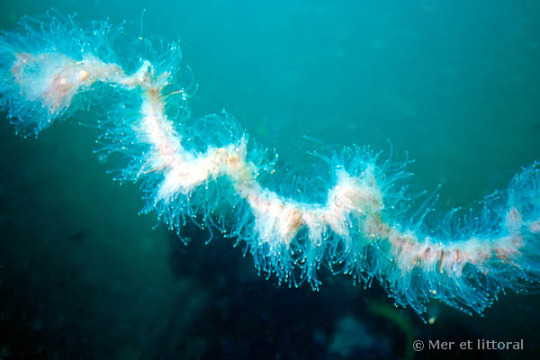
This one's called a "long, stringy, stingy thingy". No really, look it up (image: Apolemia uvaria)
The most famous siphonophore and the first one described is Physalia physalis, the Portugese man-o-war or bluebottle. It is a neuston, an organism that lives at the boundary between water and air. Its most notable feature is the enlarged float filled with carbon monoxide that keeps it floating at the surface of the water. The float functions as a sail, letting it travel thousands of miles. Stinging tentacles trail below it to collect prey. The sting of a bluebottle is very painful to humans and can even be lethal in rare circumstances. Many a beach trip has been ruined by a man-o-war sting. Its morphology and development is different enough from other siphonophores that I may dedicate a whole post to it in the future.

(image: a Portugese man-o-war)
#wet beast wednesday#marine biology#biology#zoology#ecology#animals#invertebrate#cnidarians#siphonophore#animal facts
434 notes
·
View notes
Note
followed you because when you reblogged my bad communication post i loved your url !! do u have any nudibranch propaganda to share?
Hell yea i do!! This got a little long :)
These funky little dudes have the coolest morphology, something theyre well known for. They can be pretty tiny (0.4 cm) or surprisingly large (60 cm) and generally live in the tropics, though there are certainly a wide variety that live in cooler ocean water as well. Some of the more well known species are very eye catching, like the Jorunna Parva (Bunny slug) or Glaucus Atlanticus


Some of them look like funky leaves and some of them look like slugs we see on the surface too! (Did you know licking banana slugs that you find on land makes your tongue go numb? 10/10 not recommended but i was a dumb kid)
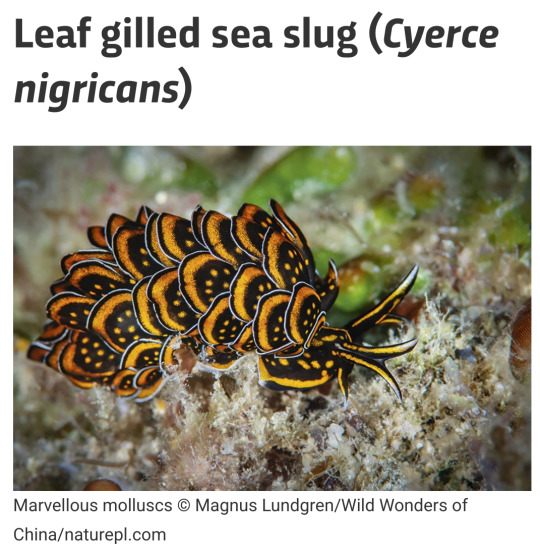
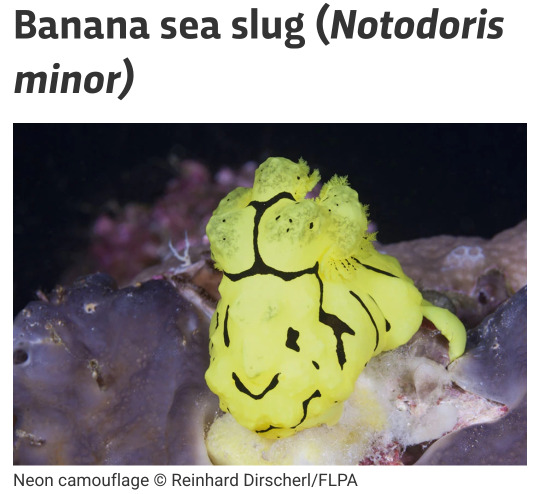
They also come in a goth or clown variant for those that are looking to fit a certain aesthetic :)

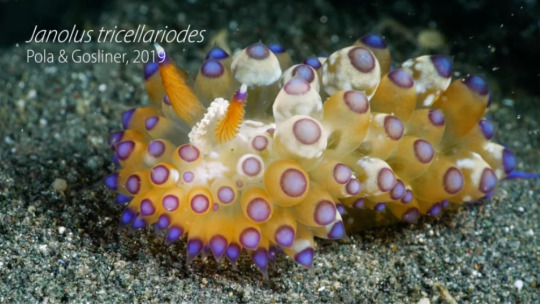
Theres two kinds of nudibranchs. Dorids, which breathe from a central plume of gills above their ass, and Aeolids, which breathe from a collection of spiky protrusions called cerata. There are a couple more distinguishing features relating to their digestive tracts and mantles (or lack thereof), but this is the easiest way to tell them apart in my opinion!


Theyre also carnivorous! These guys will eat a wide variety of stuff, including sponges, coral, barnacles, anemones, and even other nudibranchs and their eggs.
There are a couple species that have some pretty cool diets, like the Glaucus Atlantica, which preys on the portugese man of war and other siphonophores. It can eat the man of war whole if theyre small enough, but will also just eat the tentacles if theyre too big. Glaucus will then push the stinging nematocysts (the bits that hurt) from its insides to its outsides and use them as self defence!
There are also sea slugs, like the Costasiella Kuroshimae (technically not a nudibranch yada yada yada) that eat algae they then use to photosynthesize!
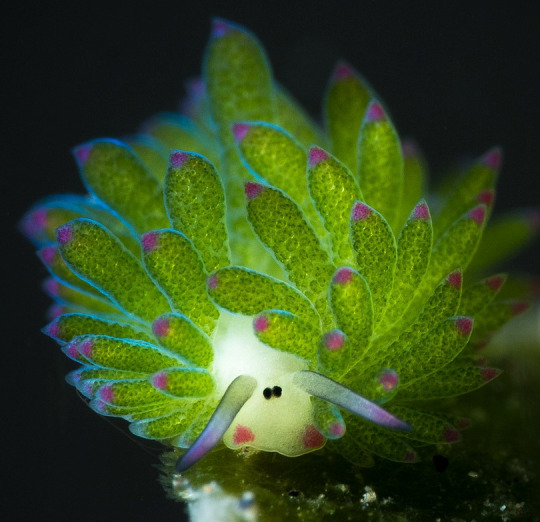
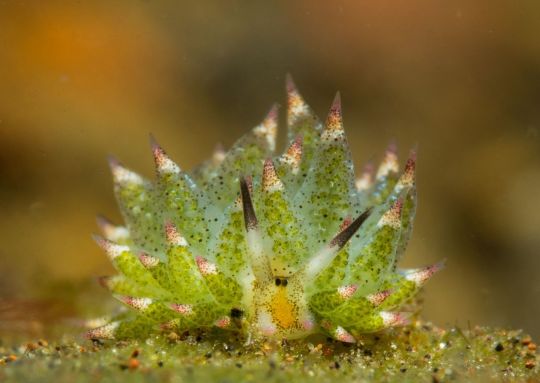
These funky little creatures are also hermaphroditic! Like a lot of animals, they use mating dances to attract a partner. Thats not whats cool about their reproduction though. When the time comes to lay their eggs, they do so in the coolest ribbon-like structures.
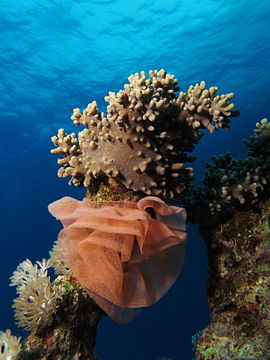
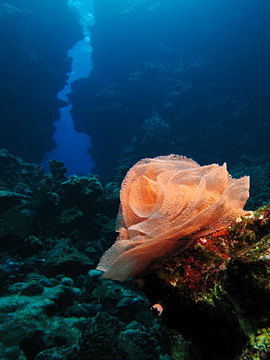
Mostly though, i just love how different all these little guys are. Personally, my fav nudi is from the ocean near where i live!

Anyways, that was rlly long. thanks if u ended up reading and defs look into these little weirdos on ur own!! (references? idk her :P but actually i dont remember where i learned most of this, though some supplemental info and pics w out credits from wikipedia!)
#syb rambles#nudibranch#sea slugs#marine biology#these r my specialest most favorite animals#also they cant see for shit#as someone who also sucks at seeing things#i love them so so so much#chatter
104 notes
·
View notes
Text
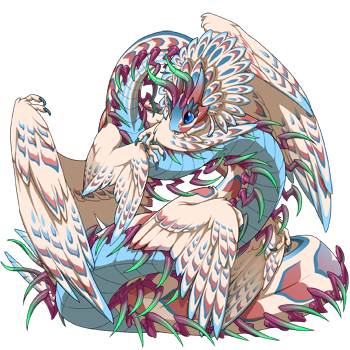


Scrying my near triple coral g1.
Trying to NOT call her Meatwater. It's hard tho because that's literally what she is
12 notes
·
View notes
Text
Its been a while since i made a post about fish and their biology, so here is today's wet beasts, THE PUFFERFISH also known as the ballonfish, puffer fish are their own own family scientifically known as "Tetraodontidae!" They are morphologically similar to the closely related porcupinefish, which have large external spines, unlike their cousins thinner and more prittle spikes
And Today i have two species of puffer that i adore and i want to share with you
One of em is the
Valentin's sharpnose puffer


Also known as the saddled puffer, because he looks like he has a little saddle on his silly little back
His binomial name is Canthigaster valentini
He is in the genus Canthigaster (seen in its sciency name)
This badboy lives in very complex social groups that kinda feel like harems..! The dom male or female has a bunch of other fish to mate with, they are also kinda territorial and really like their personal space!
While in the harem mood lets talk about their eggs and larvae
Their eggs range in size between 0.68 and 0.72 mm in diameter, making them some of the smallest in the family Tetraodontidae! (So small :'3)
The eggs are spherical with nine radial layers, the outermost layer possessing strong cleaning properties helping them avoid infections, even fish respect their personal hygiene.
Lets move on to the other star of today's wet beast THE WONDEROUS LONG SPINED PORCUPINEFISH
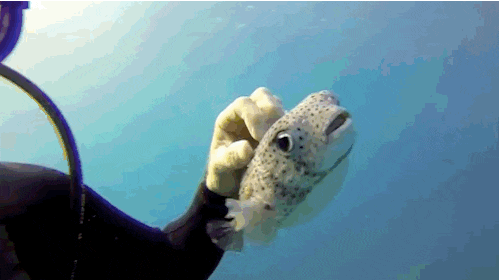

This cute little fellow is also known as the freckled porcupinefish because of its little spots all over its face!
They are found over the muddy sea bottom, in estuaries, in lagoons or on coral and rocky reefs around the world in tropical and subtropical seas!
Their are on the genus Diodon and their fancy biology name is Diodon holocanthus!
A fun fact! They spawn on the surface of the water at dawn and or dusk!
They are in fact both poisonous and venomous, so i would avoid touching them, but looking at their cuteness form afar is really great on its own!
#yeah :)#essay#marine science#marine animal#marine animals#marine biology#marine life#PUFFERFISH#pufferfish#this took way to long#i love fish so mucj
76 notes
·
View notes
Text
By ceaselessly experimenting novel genetic combinations, the prokaryotes managed to “invent” photosynthesis, aerobic respiration, nitrogen fixation, acetogenesis and methanogenesis, methanotrophy, the anammox pathway, numerous form of lytotrophy and much more. Eukaryotes, in contrast, adopted phagotrophy as the primary feeding mechanism and restrained sexual recombination within the relatively narrow space allowed by meiosis. Consequently, the main way they could expand their metabolic repertoire was through endosymbiotic association with prokaryotes. If today all eukaryotes disappeared from the Earth, global productivity would reduce dramatically and large parts of the continents would become dry, inhospitable deserts. Yet, the Earth would most likely remain a planet teaming [sic] with life, and its geochemistry would not change radically.
Conversely, if all prokaryotes suddenly disappeared, the geochemistry of the planet would be completely overturned and the eukaryotes almost certainly would not make it alone.
In spite of their superior metabolic versatility, prokaryotes are exceedingly conservative in terms of morphologic and genomic complexity, to the point that bacteria living 3 billion years ago do not appear to be morphologically different from those existing today. We do not quite understand why prokaryotes have remained morphologically simple, despite being so diverse in their biochemistry and so versatile in their ability to extract a living from gases and rocks.
Eukaryotes, in contrast, have a propensity to develop increasing complexity. Although usually retaining unicellular forms, all major eukaryote lineages independently evolved a multicellular organization, and five evolved complex multicellularity. Eukaryotes have a superior ability in niche construction encompassing the inside of their cells, multicellular organs (e.g. the animal gut and plant roots), and large-scale phenotypic extensions such as the soil, coral reefs and forest canopies up to multi-level oceanic and terrestrial ecosystems, for none of which there is a counterpart in the prokaryotic world.
-- Roberto Ligrone, Biological Innovations that Built the World: A Four-billion-year Journey through Life and Earth History, 2019, p. 222 (6.11)
15 notes
·
View notes
Text
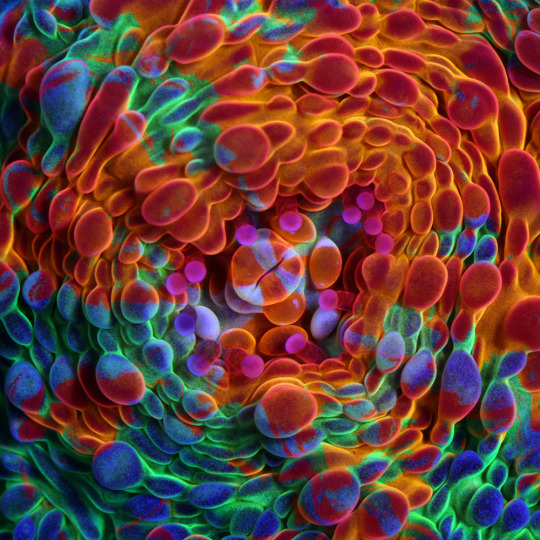
Hi, Friends! We’ve just released 8 new CM photographic prints for sale in our web shop. Purchasing a print is a great way to beautify your home while supporting our efforts to research & restore Miami’s aquatic ecosystems! 🪸📸🪸 Purchase link: https://coralmorphologic.bigcartel.com/category/photography
6 notes
·
View notes
Text
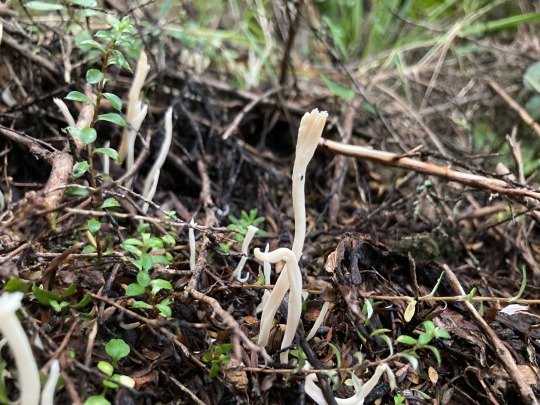
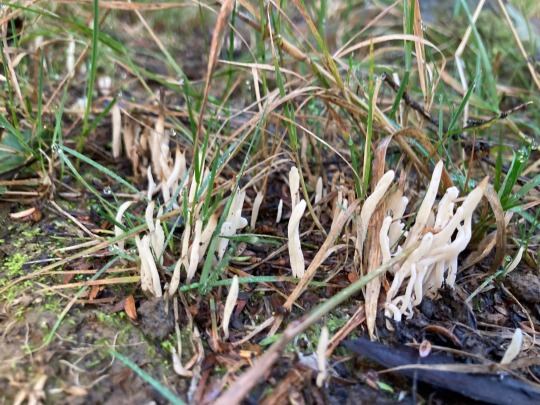
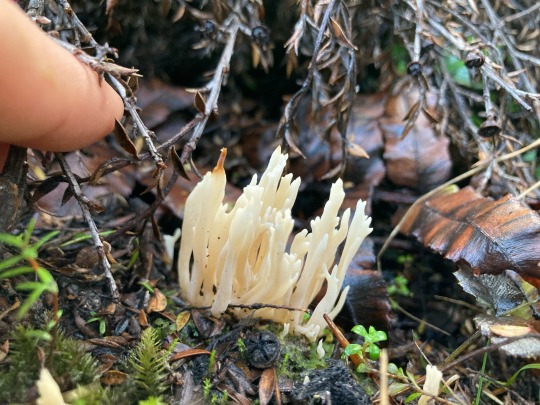
Various species of coral fungi.
The term ‘coral fungi’ is a distinction that has no basis in genetics, and is instead only based on the morphology of a fungus. As such, the term is applied to a range of genera. Here in Aotearoa, we have over 100 identified species of coral fungi, which are distributed over 10 different genera.
The first and second photos are of fungi in the genus Clavaria, which are some of the only coral fungi in Aotearoa that don’t grow into branched clumps (one species, Clavaria zollingeri breaks from this).
The second photo is likely in the genus Tremellodendropsis, but I cannot say for certain.
Source for information
43 notes
·
View notes
Text
fun fact; the government doesnt want u to know this but we don't actually know how to make circuit boards. See, in the hollow earth, there is an entire sillicon ecosystem. The boards grow like coral, and the lil chips of various sizes exist in a complex food web. from almost microscopic resitors and capacitors acting like mites, to sedate indictor species with complex twist morphology; even predatory ethernet ports and venomous many legged TSSOP phyla
7 notes
·
View notes
Text
soooo I made some morphology's and outfits for td charcters, here’s what I have so far (warning, this is gonna be long)

Gwen: outfit (Female Pearlcatcher; teal Jupiter, obsidian Basic, and emerald Basic) This is one of my personal favorites, it's simple but it works really well, but you'll see the morphologies and outfits get more complicated soooo
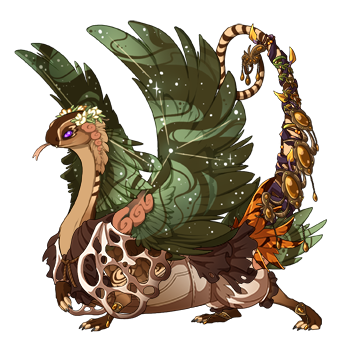
Courtney: outfit (Female Coatl; sand Cherub, camo Constellation, and wisteria Basic) Another favorite, she just looks pretty :3

Duncan: outfit (Male Bogsneak, eldritch Cinder, fern Blaze, and flaxen Basic) Silly little eepy guy, I feel like this is probably the most accurate dragon of any td character i've made. not much to say about him tho
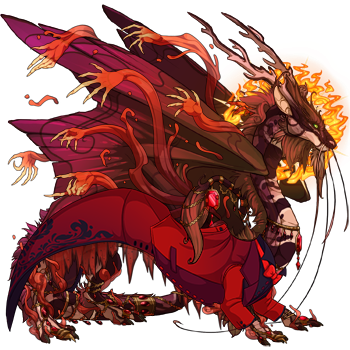
Alejandro: outfit (Male Imperial; coral Python, maroon Shimmer, and blood Smoke) This is actually a dragon that I have, you can check him out here, but it actually took a couple tries to get an outfit that I think works with him lol

Bridgette: outfit (Female Skydancer; caribbean Lionfish, sanddollar Shimmer, and cobalt Okapi) nothing much to say other than, pretty :3

Geoff: outfit (Male Pearlcatcher; magenta Clown, ivory Butterfly, and strawberry Spines) same with Bridgette, I wanted them to be matching, cause, y'know. they kiss :<, but I honestly prefer this one over Bridgette (the outfit, not the morphology)
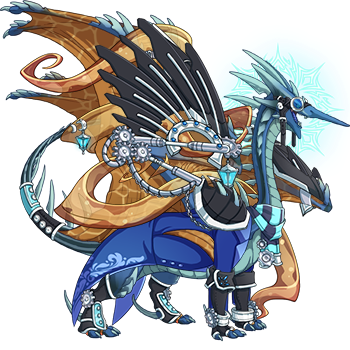
Harold: outfit (Male Ridgeback; periwinkle Skink, orange Hex, and fern Stained) I'm really happy with how this came out, even if it took a couple redos lol, and the steampunk apparel works with Harold's, vibe
ok for some stupid reason I can't put the pictures of Beth, Justin, Katie and Sadie [im on pc], so I'm just going to link the morphologies here: Beth (Female Aether; ivory Candy, magenta Butterfly, and shamrock Wish), Justin (Male Aether; bronze Boa, hunter Daub, and overcast Flutter), Katie and Sadie (Female Aberration; brown Pinstripe, ivory Flair, and cottoncandy Koi)

Ezekiel: outfit (Male Wildclaw; algae Pinstripe, soil Patchwork, and stonewash Veined) My favorite tbh, can't really explain why it just, ✨does✨

Feral Ezekiel: outfit (Male Mirror; fern Stiched, camo Patchwork, and cobalt Ghost) yeah, i made the eepy. i changed the breed cause 1) it reflects how ezekiel changed after his mutation, and 2) Male Wildclaw's position(?) isn't creaturey enough
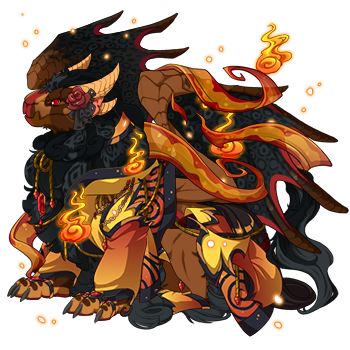
Leshawna: outfit (Female Obelisk; ginger Falcon, obsidian Rosette, and cerise Contour) Nothing much to say about this one tbh, she looks real pretty tho :D

Owen: outfit (Male Snapper; metals Ground, marigold Safari, and teal Koi) I like this one, it's simple but unfortunately i couldn't find anything to represent his maple leaf :(
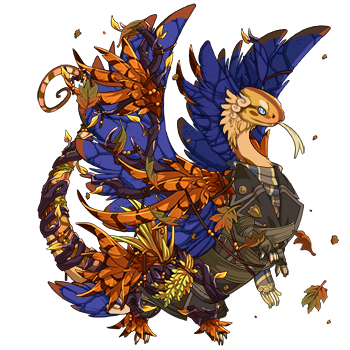
Cody: outfit (Male Coatl; gold Swirl, twilight Fissure, and copper Contour) i'm honestly not happy with this one, specifically the outfit. might redo this one later, and remove all the autumn stuff
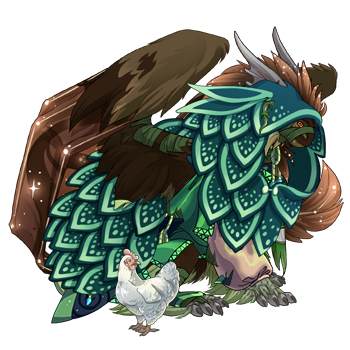
DJ: outfit (Male Tundra; camo Python, brown Constellation, and dust Runes) lookie, is my boy :3333333333

Izzy: outfit (Female Mirror; sunshine Clown, pear Eye Spots, and avocado Gembond) really happy with this one, it fits her well and gives off her craziness :>

Sierra: outfit (Female Spiral; jade Clown, mulberry Hypnotic, and blackberry Opal) i'm very lucky to have found the apparel that i did for her, cause if i didn't, i have no idea what outfit to have given her ;-; but yeah she pretty

Eva: outfit (Female Snapper; cobalt Falcon, sapphire Peregrine, and obsidian Spines) big buff lady :D

Tyler: outfit (Male Ridgeback; cherry Jupiter, sable Eel, and white Basic) A fan of this one, and the Love's Herald was a gift from Lindsay. and now thinking about it, i might wanna make some lore for this. it's a big maybe though

Lindsay: outfit (Female Fae; garnet Flaunt, honey Jester, and cornflower Scales) i don't know how to feel abt this one, not a fan of it. and also will probably redo the outfit. the morphology i can live with.

Noah: outfit (Male Nocturne; brown Jupiter, pthalo Safari, and crimson Underbelly) another favorite, it gives off very Noah vibes lol (and i just realized that he shares a gene with Owen. so do with that information as you will)

Trent: outfit (Male Skydancer; algae Viperia, forest Eel, and obsidian Koi) I love this one, gives off very bard/guitarist kinda vibes. and if there was lore, i imagine trent would be a nomad entertainer, playing in small towns and cities, and maybe at a bar or two

Chris: outfit (Male Fae; forest Falcon, teal Myrid, and obsidian Smoke) look, it's him, the guy!!!!/j but in all seriousness, this is literally just him. entitled little short king who slays (i also have one for Chef, but it's yucky :,<)
i had one for Heather, but I deleted the outfit for her, which was of a dragon that i already sold, soooooooo i'm just gonna make a new one for her :3 also thank you for reading this long ass post (if you actually did), it means a lot to me :3
#total drama#td alejandro#td noah#td courtney#td cody#td gwen#td heather#td leshawna#td dj#td duncan#td beth#td owen#td bridgette#td lindsay#td trent#td geoff#td tyler#td eva#td sierra#td izzy#td ezekiel#td feral ezekiel#feral ezekiel#td harold#td katie#td sadie#td justin#flight rising#snapper#coatl
10 notes
·
View notes
Text
pokemon is not a taxonomic category, but a morphological/descriptive one, like "tree" or "vine". there are non-pokemon animals*, there are non-pokemon plants. and there are things that are pokemon that were never living things to begin with, or are things like ghosts which exist entirely out of our usual conception of biology and evolution.
what defines a pokemon, then? there are many things we can point to that are definite descriptors- they can have one or two elemental types from the 18 currently known. not every pokemon can evolve (in the instant pokemon sense, not the biological sense), but every being that can evolve is a pokemon. they have up to four moves, all of which correspond to elemental types. the mechanics of EVs, IVs, natures- the nitty gritty of stats- may be diagnostic, but whether they actually "exist" in-universe or are simply game mechanic abstractions is debatable
*with regards to non-pokemon animals- humans are the obvious undebatably canon example. other non-pokemon animals such as dogs or opossums have appeared in-canon in the early generations, but are very debatably non-canon. however, some animals such as sea stars, clams, and coral have appeared in pokemon media as recently as the xy & sumo animes.
30 notes
·
View notes
Photo
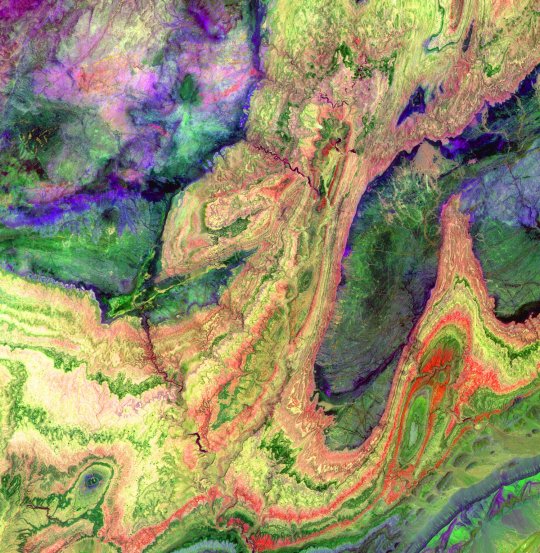
The Anti-Atlas Mountains of Morocco formed as a result of the collision of the African and Eurasian tectonic plates about 80 million years ago. This collision destroyed the Tethys Ocean; the limestone, sandstone, claystone, and gypsum layers that formed the ocean bed were folded and crumpled to create the Atlas and Anti-Atlas Mountains. In this ASTER image, short wavelength infrared bands are combined to dramatically highlight the different rock types, and illustrate the complex folding. The yellowish, orange and green areas are limestones, sandstones and gypsum; the dark blue and green areas are underlying granitic rocks. The ability to map geology using ASTER data is enhanced by the multiple short wavelength infrared bands, that are sensitive to differences in rock mineralogy. This image was acquired on June 13, 2001 by the Advanced Spaceborne Thermal Emission and Reflection Radiometer (ASTER) on NASA's Terra satellite. With its 14 spectral bands from the visible to the thermal infrared wavelength region, and its high spatial resolution of 15 to 90 meters (about 50 to 300 feet), ASTER images Earth to map and monitor the changing surface of our planet. ASTER is one of five Earth-observing instruments launched December 18, 1999, on NASA's Terra satellite. The instrument was built by Japan's Ministry of Economy, Trade and Industry. A joint U.S./Japan science team is responsible for validation and calibration of the instrument and the data products. The broad spectral coverage and high spectral resolution of ASTER will provide scientists in numerous disciplines with critical information for surface mapping, and monitoring of dynamic conditions and temporal change. Example applications are: monitoring glacial advances and retreats; monitoring potentially active volcanoes; identifying crop stress; determining cloud morphology and physical properties; wetlands evaluation; thermal pollution monitoring; coral reef degradation; surface temperature mapping of soils and geology; and measuring surface heat balance. Dr. Anne Kahle at NASA's Jet Propulsion Laboratory, Pasadena, California, is the U.S. Science team leader; Bjorn Eng of JPL is the project manager. The Terra mission is part of NASA's Earth Science Enterprise, a long- term research effort to understand and protect our home planet. Through the study of Earth, NASA will help to provide sound science to policy and economic decision-makers so as to better life here, while developing the technologies needed to explore the universe and search for life beyond our home planet. Size: 28.7 x 29.4 km (17.8 x 18.2 miles) Location: 29.4 deg. North lat., 8.9 deg. West long. Orientation: North at top Image Data: ASTER bands 4,6 and 8. Original Data Resolution: 30 m Date Acquired: June 13, 2001
3 notes
·
View notes